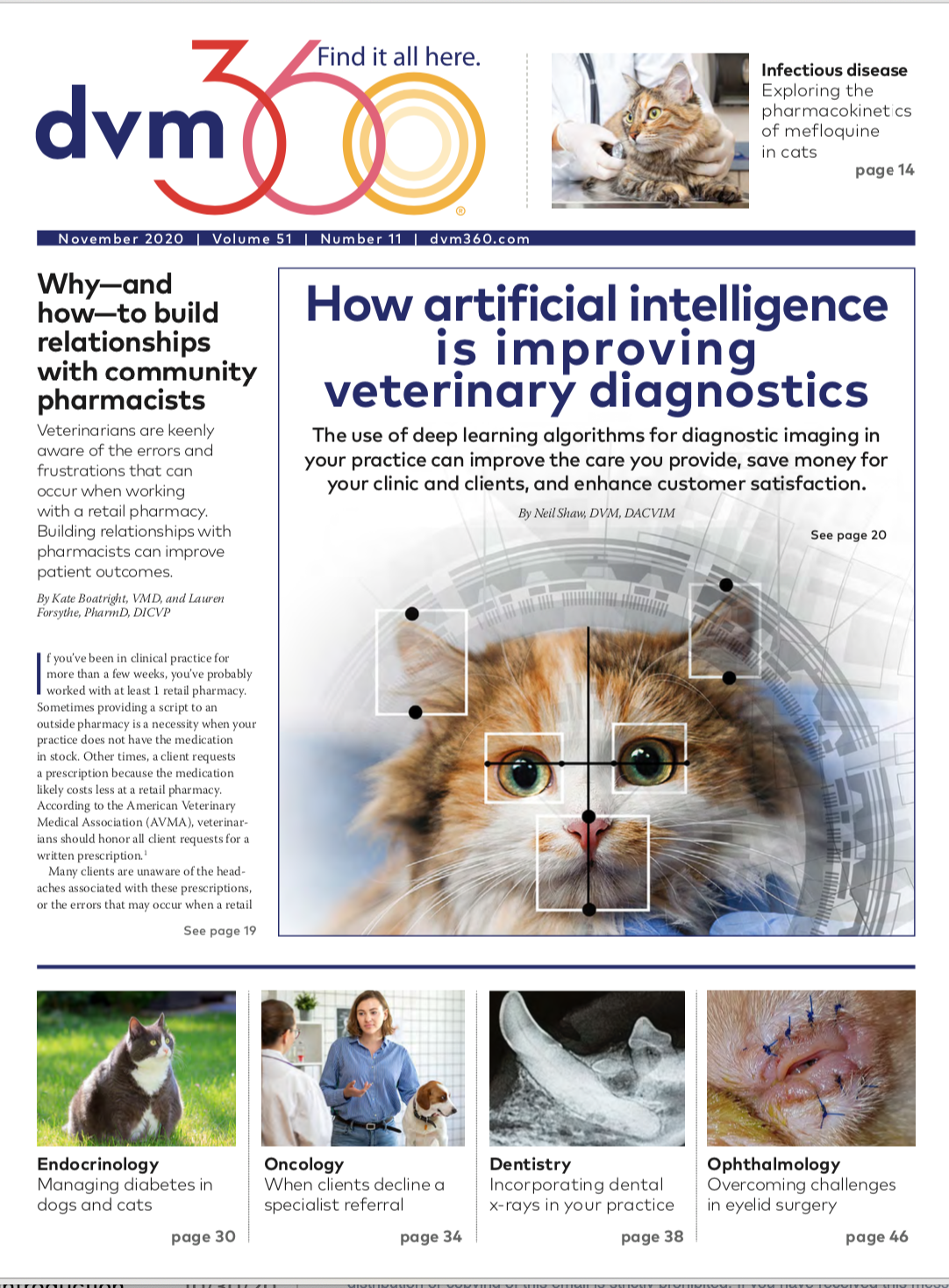If you’ve been in clinical practice for more than a few weeks, you’ve probably worked with at least 1 retail pharmacy. Sometimes providing a script to an outside pharmacy is a necessity when your practice does not have the medication in stock. Other times, a client requests a prescription because the medication likely costs less at a retail pharmacy. According to the American Veterinary Medical Association (AVMA), veterinarians should honor all client requests for a written prescription.1
Many clients are unaware of the headaches associated with these prescriptions, or the errors that may occur when a prescription is filled by a retail pharmacy. In 2012, the Oregon Veterinary Medical Association released the results of a survey investigating outcomes when veterinarians scripted medications to both online and brick-and-mortar retail pharmacies. Of the veterinarians surveyed, 35% had experienced an instance in which a retail or online pharmacy changed a prescribed dose or changed the medication itself without contacting the prescribing veterinarian, with 16.5% reporting that these changes led to adverse effects for the patient.2 Understanding why these problems arise and building relationships with pharmacists in your community can help to improve outcomes for your patients.
Why conflicts arise between veterinarians and pharmacists
Just as veterinarians are bound by ethical and legal obligations that govern the practice of veterinary medicine, pharmacists have professional requirements to which they must adhere. Pharmacists are legally required to verify the accuracy and validity of each prescription they fill, and to advise clients about potential side effects and drug interactions. For medications intended for people, this is simple to do because pharmacists have the knowledge and resources to fulfill these requirements. Unfortunately, pharmacists do not receive training in veterinary pharmacology as part of their core curriculum. This opens the door for error because for some drugs large differences exist between humans and animals with regard to in dosing and side effects.
Although it is easy to say that pharmacists should receive more education and have access to veterinary pharmacology resources, making this a reality is not so simple. The AVMA and National Association of Boards of Pharmacy (NABP) have worked together to increase awareness of the problems for both veterinarians and pharmacists and encourage the addition of veterinary pharmacology education to pharmacy school curricula.3,4
The NABP has also modified its model practice act to add a requirement that a veterinary drug reference be available in any pharmacy where veterinary medications are dispensed.4 To date, only a handful of states have implemented this recommendation. If you are in a state that does not currently require a veterinary drug reference to be on hand in pharmacies filling pet medication prescriptions, consider reaching out to your state veterinary medical association. Encourage them to start a conversation with the state pharmacy board and advocate for this change.
Tips for building working relationships with community pharmacists
- A recent survey of veterinarians and pharmacists in Ohio found that members of both professions felt that interprofessional collaboration was important to optimizing outcomes for veterinary patients.5 Sometimes, veterinarians become overwhelmed when working with pharmacies, developing a negative outlook on collaboration because of previous experiences. Here are several ways you can establish productive working relationships with pharmacists in your area:
- Open the lines of communication with local pharmacies by visiting them or sending a letter (the AVMA has a sample letter available at avma.org/model-letter-pharmacists). Introduce yourself and express your desire to work with the pharmacy for the best possible veterinary patient outcomes. Encourage the pharmacy team to contact you with any questions regarding pet prescriptions.
- Donate an old copy of your favorite veterinary drug reference to your local pharmacy. Doing so may decrease the number of phone calls you receive from pharmacists.
- Provide handouts for pharmacists that can serve as a quick reference guide on common toxins (eg, xylitol, acetaminophen) and prescription concerns (eg, changes in insulin type, thyroid medication doses).
- Maintain patience when pharmacists do call with questions. Use these conversations as a chance to educate pharmacists and encourage them to continue calling.
- Educate pharmacies about identification numbers. Many pharmacies will call asking for a national provider identifier (NPI) or Drug Enforcement Agency (DEA) number to fill a prescription. (The NPI is an identification number used for Medicaid patients.) Instead of saying “I don’t have an NPI number, and I won’t provide a DEA number for noncontrolled substances,” consider letting the pharmacist know why you don’t have an NPI and that the DEA opposes the use of a DEA number for identification purposes.6
- Always provide clear prescriptions. Written prescriptions are the best way to reduce miscommunication. Typed prescriptions are preferred, but legible, hand-written prescriptions are acceptable. Write out the entire prescription and avoid using abbreviations such as SID (once daily), which are not used in human medicine. Specify “no substitutions” when applicable, and write “must not contain xylitol” when prescribing suspensions, orally disintegrating tablets, and human chewable tablets.
- Reach out to local pharmacy groups or schools and offer to provide a lecture on veterinary prescriptions.
Even with relationship building and improved education, errors may still occur. In these cases, it is important to reach out to the pharmacy to advise them of the error and discuss how to avoid the same error in the future. Additionally, errors can be reported to both the AVMA and the state pharmacy board.
Ultimately, it will take both veterinarians and pharmacists working together to improve the situation and prevent errors. Problems with pharmacies are common and frustrating for veterinary teams, but we encourage veterinarians to take the first step toward bettering working relationships. Neither the veterinarian nor the pharmacist wants to see a patient harmed, but it is only by working together that we can reduce conflict and maximize patient safety.
Kate Boatright, VMD, a 2013 graduate of the University of Pennsylvania, is an associate veterinarian and freelance speaker and author in western Pennsylvania. She is actively involved in organized veterinary medicine at the local, state, and national levels and is a former national officer of the Veterinary Business Management Association.
Lauren Forsythe, PharmD, DICVP, is a licensed pharmacist who is board certified in veterinary pharmacy. She has worked in retail pharmacy and currently supervises the pharmacy at the Veterinary Teaching Hospital at the University of Illinois.
References
1. Principles of veterinary medical ethics of the AVMA. American Veterinary Medical Association. August 2019. Accessed October 3, 2020. https://www.avma.org/resources-tools/avma-policies/principles-veterinary-medical-ethics-avma
2. Kolb G. Veterinary prescriptions & retail pharmacies summary of membership survey. Oregon Veterinary Medical Association. September 2012. Accessed October 3, 2020. https://www.ftc.gov/sites/default/files/documents/public_comments/request-comments-and-announcement-workshop-pet-medications-issues-project-no.p121201-560891-00569/560891-00569-84588.pdf.
3. Regulators and stakeholders explore means to support safe dispensing of pet medications by community pharmacies. Newslett NABP. 2013;42(7):145-147.https://nabp.pharmacy/wp-content/uploads/2016/08/August_2013_NABP_Newsletter.pdf
4. Updated Model Act Available; Amended Language Addresses Timely Pharmacy Practice Topics. Newsletter NABP 44(8):157-158.
5. Fredrickson ME, Terlizzi H, Horne RL, Dannemiller S. The role of the community pharmacist in veterinary patient care: a cross-sectional study of pharmacist and veterinarian viewpoints. Pharm Pract (Granada). 2020;18(3):1928. https://doi.org/10.18549/PharmPract.2020.3.1928.
6.Inappropriate requests for Drug Enforcement Agency (DEA) registration numbers. American Veterinary Medical Association. Accessed October 3, 2020. https://www.avma.org/resources-tools/avma-policies/inappropriate-requests-drug-enforcement-administration-dea-registration-numbers.

